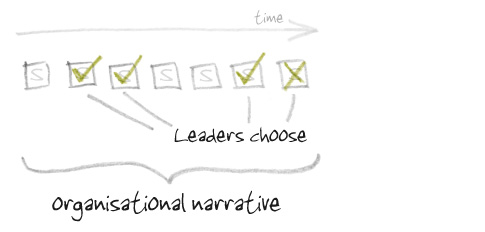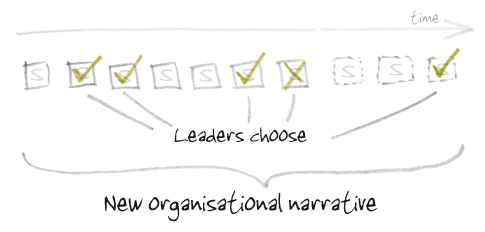Blog
Subscribe
Join over 5,000 people who receive the Anecdotally newsletter—and receive our free ebook Character Trumps Credentials.
Categories
- Anecdotes
- Business storytelling
- Collaboration
- Communication
- Corporate Storytelling
- Culture
- Decision-making
- Employee Engagement
- Events
- Fun
- Insight
- Leadership Posts
- News
- Podcast
- Selling
- Strategy
Archives
- April 2024
- March 2024
- December 2023
- November 2023
- October 2023
- September 2023
- August 2023
- July 2023
- June 2023
- May 2023
Years
A strategic approach to organisational narratives
Narratives are a connected set of stories that together form a bigger story, one with a beginning, middle and end.
It’s a bit like a movie in which each scene is itself a small story. Take Star Wars. Early in the movie we meet Luke, who is living with his aunt and uncle, farming moisture on a remote homestead. One day he heads out in search of a wayward droid he bought, and when he returns he finds that his family has been slaughtered by Imperial Stormtroopers.
If something as bad as this happened to a family in our own city, there’s a good chance we would hear about it and we’d probably tell the story to someone else. It’s a small story in the larger Star Wars narrative.
But organisational life is not like a Hollywood movie, where each event is precisely crafted for maximum entertainment effect. When stories arise in a company, which happens all the time, it’s the leader’s role to choose which ones to tell, which to ignore, which to replace, even which new stories to trigger.
The choice that leaders make regarding which story to amplify is dependent on the context, strategy and desired culture in that period of the organisation’s existence. A leader’s values also have an impact. But these are not merely the result of top-down pressure exerted by a leadership team. Context is also created by the stories already being told. All the stories being told in an organisation reflect its culture. And if you want to change a culture, you will need to change the stories being told.
The Bible is a good example of a collection of stories that has been drawn on by leaders over an eon. It contains more stories than have ever been told by any one leader, church or even denomination. Rather, over the years, different leaders have selected different subsets of stories to tell that reflect their own purposes and goals. At the same time, their story choices have been filtered by what society wants or deems acceptable.
The same is true for organisations. Every company has a history. But rather than just relate that history, leaders need to choose stories from it – including ones from the here and now – which explain their strategies, their desired ethos and the principles that will bring their strategies to life.
So it’s important for a company to be aware of its stories, the ones that have been told and the ones being told right now. It’s only when armed with this knowledge that an organisation can choose what to emphasise and what to replace.
Unfortunately, with so much churn taking place in organisations, many of these stories are unknown to leaders. An extra complication is the misguided belief among some leaders that they should only focus on the future and leave the past behind. However, it’s been said that those who forget the past are doomed to repeat it. Worse still, leaders who are unaware of the past are unable to predict how people might react to new initiatives. Our stories are our best tool for predicting the future.
Stories are very much like habits – you can’t just stop a story; you can only replace it with a better one. This means understanding the triggers that cause a story to be told and working out the benefits of that story for the teller and the audience. Only then do you stand a chance of replacing it.
Narratives and Endings
Whether it’s a small story or the overarching narrative in which it sits, an ending helps make the point. Much of the meaning is wrapped up in the end. In selecting which stories to tell, leaders also select endings. Without those endings the listener is left hanging, and no-one likes to be left hanging. “To be continued” is the worst possible way to end a story.
Organisational narratives never sits still. Time rolls on and new story-worthy events happen. Leaders must choose new stories to add to the organisational narrative and decide to drop others. The narrative evolves.
In the case of the overarching narrative, the ending should not be confused with the storytelling skill of selecting an ending. When a leader selects a series of stories to create a (new) narrative, the stories fit together to form a beginning, middle and end, each element contributing to the point of the story.
Organisations should be looking to harness the complexity of their organisational narratives. Leaders cannot simply mandate a company story. But to forge the business they want, they should be aware of which stories are being told, and which stories they would like to be told and start recounting the ones they want to amplify.
Thanks to Col Duthie for the terrific conversation that sparked this post and taking a look at an early draft.
About Shawn Callahan
Shawn, author of Putting Stories to Work, is one of the world's leading business storytelling consultants. He helps executive teams find and tell the story of their strategy. When he is not working on strategy communication, Shawn is helping leaders find and tell business stories to engage, to influence and to inspire. Shawn works with Global 1000 companies including Shell, IBM, SAP, Bayer, Microsoft & Danone. Connect with Shawn on:
Comments
Comments are closed.



Hi Shawn,
Really interesting stuff. You were one of my first Linkedin contacts and I would love to catch up next time you are in Brisbane.
Regards
Warren
Thanks Warren. Love to catch up. I’m starting a project in Brisbane next year so plenty of opportunity to catch up.
Another great post Shawn.
Just want to pick up on one point you made if I may:
“All the stories being told in an organisation reflect its culture. And if you want to change a culture, you will need to change the stories being told.”
I think that’s absolutely true for the inside story. But, with a couple of minor tweaks, I think it equally applies externally:
All the stories being told by an organisation reflect its brand. And if you want to change the brand, you will need to change the stories being told.
Thanks as always. Mark.
What you are saying makes a lot of sense to me. I’m working on a brand project as I write this comment up in Singapore. And the client is very aware of how the small stories affect their brand and the importance of sharing ones that illustrate the brand in action.